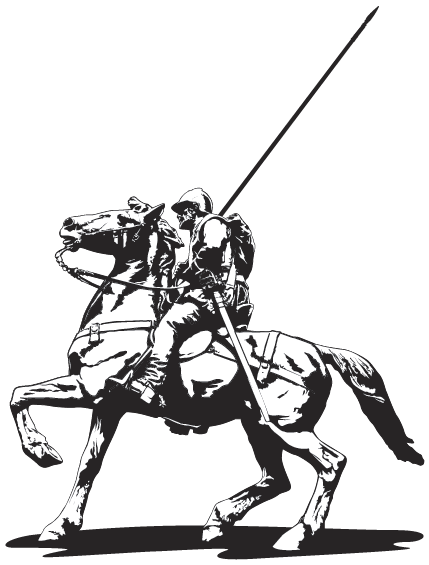
Clan Maxwell Society
THE BORDER REIVERS
Larry Long, Kingsport TN
The period from the War of Scottish Independence, about 1315, until the union of crowns, in 1603, was one of conflict along the border between England and Scotland. Both sides resorted to the use of wardens — royally appointed overseers — to keep things under control. It was seldom a very firm grip on either side of the border.
The term “reiver” probably applies best to the latter part of that period, the mid to late 16th century. This corresponds to a period which included the rules of Henry VIII, Elizabeth I, and Mary Queen of Scots. It was the term applied to mounted raiders who stole livestock and goods and engaged in a highly organized “protection racket.” The term “blackmail” in the English language dates from this period.
The term reivers was applied collectively to a number of families who were classed as “riding families:” i.e., they habitually raided on horseback. To “reive” was “to lift” or in the more modern term “to steal.” In the American west, the term “rustle” was used in a similar way. An excellent look at the border culture of the period can be found in the book, The Steel Bonnets, by George MacDonald Fraser. The most notorious of the riding families lived in the Middle March of Scotland, east of the area administered by the Maxwells. As a warden, the Maxwell chief would be charged with keeping the peace and redressing any wrongs charged to people under his jurisdiction. There is no record of Lord Maxwell going reiving, but one can certainly wonder if some of his tenants went along for the rides (and the booty).
Nicknames or bynames may give us an inkling of what colorful characters they were. How would you like to meet a man called “Archie Fire-the-Braes” or “Out-with-the-Sword” or “Cleave-the-Crune (Crown)” on the other end of a 13 foot steel tipped lance? These border riders were a colorful lot. Steel helmets or bonnets, body armor, and propensity for risk-taking made them a fierce and contentious lot.
Phillip Johnson, Madison AL

Have you ever thought about researching your family tree and joked about finding a bunch of cattle rustlers? Welcome to the Scottish Borders and Border Reivers!
The “Borders” stretch across Scotland from the Solway Firth in the west to Berwick-Upon- Tweed in the east. There, along the borders, you will find the Cheviot Hills and more than a few rivers with names such as Nith, Annan, Esk, Teviot, and Tweed. This is a landscape that varies from salt marshes to the fertile plains of the Merse and from Moss bogs to the bleakness of nature’s own barrier, the Cheviot Hills.
The Borders are divided into three Marches: West, Middle, and East. The Marches were established by the “Laws of the Marches” agreement in 1249. An “appointed” March Warden administered each March, and “appointed” really meant “self-appointed.” The Scottish Warden was usually the Chieftain of the home family, and his principal duty was to keep the peace. He also conducted diplomatic talks with his opposite number or other senior court officials, and he would sometimes lead his Wardenry’s men to war. Often he was first in the fray simply because of geographical position. Running intelligence networks also came within his powers, and as local governor he acted as judge, administrator, inspector and sometimes executioner.
The West March consisted of Stewardries of Kirkudbright and Annandale, and the Sheriffdom of Dumphries. The Warden of the West Marches was most often a Maxwell, with the Dumphries serving both as judicial center of the West March and the Warden’s headquarters. The Maxwells frequently held the Wardenship because of their castles at Caerlaverock, Lochmaben, and Langholm. Caerlaverock, built around 1280, was the Maxwell stronghold, located at the mouth of the Nith River. Langholm Castle was the home of the “Keeper of Annandale,” who was a Captain of the March Warden.
And just what is a Reiver? George MacDonald Fraser best answers the question in his book, The Steel Bonnets:
“The great border tribes of both Scotland and England feuded continuously among themselves. Robbery and blackmail were everyday professions; raiding, arson, kidnapping, murder, and extortion were an accepted part of the social system. While the monarchs of England and Scotland ruled the comparatively secure hearts of their kingdoms, the lance and the sword dominated the narrow hill land between. The tribal leaders from their towers, the broken men, and outlaws of the mosses, the ordinary peasants of the valleys, in their own phrase, ‘shook loose the Border.’ They continued to shake it as long as it was political reality, practicing systematic robbery and destruction on each other. History has christened them the Border Reivers.”
A little wild, a little rambunctious? Hey, they brought new meaning to “free enterprise.” For all of the negatives said about the Reiver, he was a unique persona. The Reiver did not belong to any specific social group, but rather came from all social classes. Reivers were laborers, gentleman farmers, peers of the realm, fighting men, and professional cattle rustlers. The Reiver perfected the “Protection Racket” three hundred years before Al Capone and enriched the English language with words such as “blackmail” and “kidnapping.” Reivers were accomplished at tracking, hiding, and ambush. They could hide a 1,000 head of cattle in one of hundreds of glens and wait for a “Hot Trod” to end.
A “Hot Trod” was a process allowed under Border rules for pursuing one’s pilfered livestock across the border. Riding around in the daytime was dangerous enough, but a posse riding around at night after the rustlers could end up starting a full-scale war. The victim had two avenues of recourse. He could file a complaint with his Warden who was lawfully bound to investigate the crime; however, a more common road was to gather a posse of friends to pursue the thieves. This was colorfully known as “hot trod,” and this is where the rules came in. To insure the safety of the posse, the leader rode at the head displaying a piece of burning turf on a lance, and the pursuers had to inform the first person they met over the Border that they were on a “hot trod” foray. This was supposed to insure their safe passage across the border and back. If the posse caught the rustlers within 24 hours, they could fight to retrieve their livestock. If the posse was unsuccessful, the Reivers went free and the livestock was theirs.